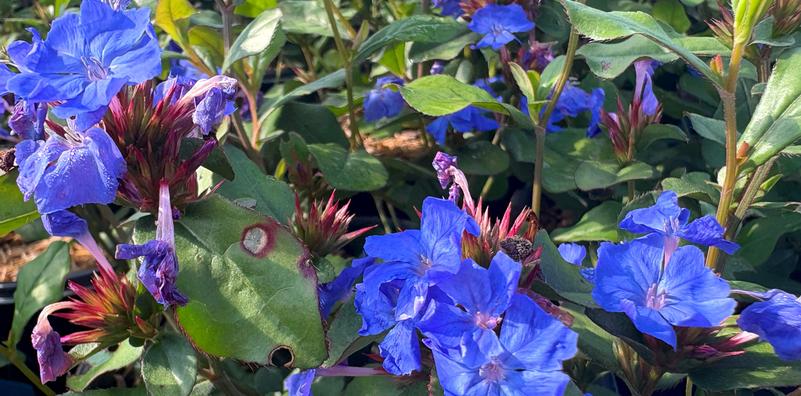September Serenity
The nursery is bustling with activity this month, with deliveries and pick-ups keeping our loading area packed nearly every moment of the work day, perennials happily pushing their final blooms for the year and pollinators eagerly lapping up their bounties, and deciduous woodies cloaking themselves in their annual fall couture collection of burgundy, maroon, bronze, umber, sienna, crimson, and saffron hues. This is the time when the blues, indigos, and ultraviolets of flowering perennials emerge in full force, contrasting hypnotically against the golden glow of the late afternoon autumn sun.
Perhaps there is a deeper reason, one more psychologically bound, that keeps gardeners pining for these colors in their landscapes year round – blue and indigo hues have been found to induce a sense of calm and peacefulness, whether as the interior paint color of a bedroom or children’s hospital, or as the natural jewels embellishing the exteriors of our homes and landscapes. This conspicuous and often difficult-to-find-in-nature color palette has come to represent the idea of Serenity – and just like the bee species that inherently find themselves attracted to blue-colored flowers, us humans have developed a subconscious attraction to these colors in nature, as well.
The stimuli response to different colors within the human brain has been studied rather extensively, with some research geared specifically towards the brain’s response to plant colors. Interestingly, even the slightest alteration of a color, be it the shade or tone, can greatly influence the psychological response from person to person. While dark green might promote feelings of comfort, a brighter green or a chartreuse may generate feelings of cheerful excitement.
Blue flowering plants, due to their scarcity in the natural world, are limited in these findings, with one report concluding that people were less likely to be attracted to blue flower plants than red, yellow, or even white flowers. Conversely, a 2019 study found that spaces including yellow and blue promoted feelings of pleasure, and in higher quantities than their red-colored counterparts.
The same study found that both blue and green colors are most closely related to feelings of relaxation and “psychological stability”, based on the eye movement and brain activity of participants in the study (Jang, et al. 2019). Perhaps it is our human relationship to natural blue elements such as water and the sky that makes blue such a comforting color to us - entities in nature that our primitive brains understand to be essential. Or maybe it is simply the rarity of its existence in the foods we consume, the natural world around us, and our everyday lives that have been inundated with greige that makes blue so profoundly interesting to us. When one witnesses an Eastern bluebird darting through a meadow, an iridescent turquoise dragonfly settling on a leaf, or an unexpected Lobelia siphilitica volunteer along a pond’s edge, it inspires the feeling of having experienced a phenomenon.
While it’s rare that we are lucky enough to encounter blue flowers in the wild, we are fortunate enough to have a handful of options for our homegrown, commercial, and restorative landscapes. From our humble native asters to the electric blue blooms of ornamental groundcover Ceratostigma plumbaginoides, there is a blue-flowering plant to delight and surprise in nearly every landscape.
Don’t let the blues get you down - check out our list of blue and indigo-flowering plants to add to your next order!
Aster laevis ‘Bluebird’ | smooth aster | (2,415 #1’s Available)
Aster macrophyllus ‘Twilight’ | big leaf aster | (596 #1’s Available)
Aster ‘Wood’s Light Blue’ | wood aster | (313 #1’s Available)
Ceratostigma plumbaginoides | plumbago | (1,225 #1’s Available)
Conoclinium (syn. Eupatorium) coelestinum | hardy blue mist flower | (488 #1’s Available)
Lobelia siphilitica | blue cardinal flower | (962 #1’s Available)
Scutellaria ‘Appalachian Blues’ | skullcap | (186 #1’s Available)
References:
Elsadek, M., Sayaka, S., Fujii, E., Koriesh, E., Moghazy, E., & Abd El Fatah, Y. (2013). Human Emotional and Psycho-Physiological Responses to Plant Color Stimuli. Journal of Food, Agricultural & Environment, 11(3 & 4), 1584–1591. https://www.academia.edu/10193754/Human_emotional_and_psycho_physiological_responses_to_plant_color_stimuli
Jang, H. S., Gim, G. M., Jeong, S. J., & Kim, J. S. (2019). Changes in physiological and psychological conditions of humans to color stimuli of plants. Journal of People, Plants, and Environment, 22(2), 127–143. https://doi.org/10.11628/ksppe.2019.22.2.127

Ceratostigma plumbaginoides

